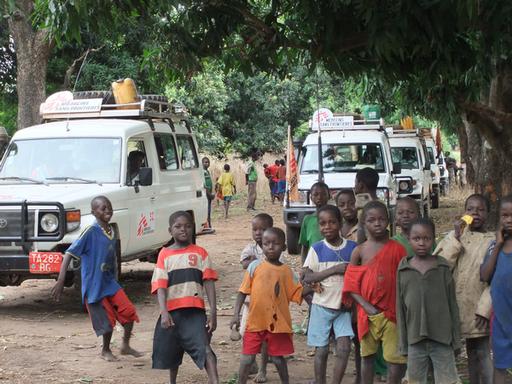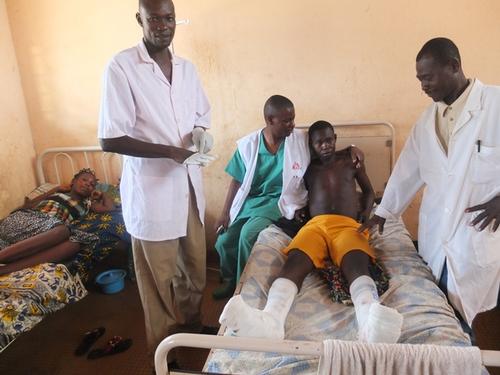When I first meet Margarete, she is returning from the bush, carrying her medical bag. She says, “That woman’s uterus was out. She was dying. I put it back in. She will need more treatment but we may have saved at least one life today.” She smiles. Simple.
“Cinq-sur-cinq,” Margarete yells into the car radio. “Bon. Mobile vingt cinq. Direction Bravo Julie.” Her French is practical, not poetic, as she reports on our movements. That’s what they call this crazy car trip: a “movement”.
With missions from Congo, Haiti and Ivory Coast under her belt, she embodies a combination of pragmatic Africa-hand mentality and German professionalism that makes her a considerable force as she leads her Equipe Margarete (team Margarete) on their “movements” through the jungles of central Africa.
10 hours on the road, 100 times over
We pass four men with machine guns, then a truck carrying an unseemly amount of timber destined for Chad, but currently stuck in a ditch. We carry on, across the market road, food stalls, past a couple of confused chickens – and that’s it: we’re through the town of Boguila. The dirt track is bumpy, which isn’t a surprise: Central African Republic has only a few kilometres of paved road. Few people know this better than Margarete.
“I’ve done this drive four times a week for three months,” she says. “I must have done it 100 times already. I come back tired after maybe 10 hours on the road, but I like it. I like getting out to the people who live here. And every day there is something new in this job. Hey, look, there is the public swimming pool.”
The “pool” is a small river, doubling as a bathhouse, launderette and local café. The Land Cruiser drives through it with ease, and we decline invitations from the swimmers to join them in the water.
We’ve just left Boguila hospital in the north of Central African Republic. We’re driving out to the villages to check up on patients, and to vaccinate against polio, diphtheria, tetanus, whooping cough, measles and yellow fever.
Too many children in Central African Republic are not lucky enough to get these vaccines, and so it is left to MSF, and nurses such as Margarete, to pick up the slack.
“A nice follow-up”
The jungle around us gives way to the village of Boyanga. We pull up next to a gathering of people. Margarete greets her colleagues from the government health service, and is welcomed by the 50-odd people who have lined up to be consulted by the MSF team.
Margarete recognizes a waiting woman right away. They talk in French, some translated into Sango, the local lingua franca.
“This is Gloria and baby Nina,” she tells me. “Nina was malnourished when I found her about a month ago. And she also had malaria. She was very sick.”
“Malaria and malnutrition often go together,” Margarete continues. “This increases the risk of death. But if a child is well nourished, he or she can live a few days with malaria, and we can still save them. So I entered Nina into the feeding programme and gave her Plumpy’Nut, to take three times a day.”
Plumpy’Nut is a peanut-based paste complete with vitamins and minerals that allows MSF to treat severe non complicated malnutrition without taking the patients to hospital, since the packets can be given at home. It’s a calorie bomb that saves lives.
“Now, two weeks later, I see that she is getting very good. She has gained weight – from 6.7 kg to 7.2 kg in only a month. She is over the crisis and she has no longer malaria. I will keep her for two more weeks in the programme, and then she will be fine. To have a follow-up like this is very nice,” concludes Margarete as we get ready to move on.
A catastrophe
Some time later we pull up in Boaya. The team starts getting the area ready for a vaccination session. In 15 minutes, the village centre has been turned into a screening area and three vaccination posts, complete with queue management and rubbish collection. And when the clinic opens, it feels a bit like being inside a movie theatre. Noisy, crowded – even fun.
Not long after, Margarete gets a call on the walkie talkie. The sound barely cuts through the growing noise of small children wailing their disapproval of the vaccine needles.
“A catastrophe,” she tells me. “A young girl has been taken to the health post, she is already unconscious. Possibly cerebral malaria.”
Margarete runs off. I follow.
The girl has been brought by her father on the back of moped. It took three hours to get here. Along the way, she lost consciousness. She is convulsing. Her name is Gisela Youxienne. She is three years old.
“It looks like malaria, combined with malnutrition. Convulsions… could also be tetanus.”
Margarete talks while she examines the girl, then stops talking to concentrate on her work. I leave her to it.
A forgotten heart
“She is stable, but we have to bring her to the hospital,” says Margarete, coming out of the health post some time later. “I’m not sure if she will make it. If she had come two days ago, then maybe… “
Margarete looks troubled. “Children are dying all the time. As many children die, here as in wars or other crises. But nobody seems to care. I don’t get it, I really don’t. We’re in the heart of Africa. But it’s a forgotten heart.”
We drive on. The vaccinations went well. Over 100 children will have gained a stronger chance of making it past five years old. And we have brought Gisela with us, to take her to the emergency ward, where she will have a better chance of survival. But still, it’s hit and miss.
We drive in silence. I wonder how Margarete manages to keep her spirits up, doing this day after day. As we pull up outside Boguila hospital, she answers my question without being asked:
“The best part of my job is to work closely with the people – to really be a nurse.”
Simple.






